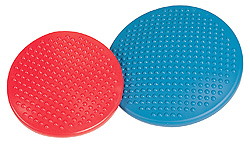Energetic sitting improves focus for children who can't sit still
|
For children with a sensory disorder such as attention deficit and hyperactivity, processing the daily onslaught of information coming through their senses is difficult. In response, these children often exhibit poor balance, poor posture, constant fidgeting and poor attention, especially in the classroom. The Disc ‘O’ Sit* cushion — a round, air-filled cushion with raised bumps all over it — has been shown to help children stay more focused in an academic setting, |
 Photo courtesy Ball Dynamics International, LLC
Disc 'O' Sit cushion
|
|
according to a study published recently in The American Journal of Occupational Therapy. It is theorized that the cushion, designed to provide movement while seated, helps the students increase their attention to task because they are permitted to actively move, said Beth Pfeiffer, Ph.D., OTR/L, BCP, lead author and assistant professor of occupational therapy at Temple University’s College of Health Professions. Another benefit, she added, is that the cushions are relatively inexpensive and can be easily used with little stigma or distraction of the other students in the class. Occupational therapists like Pfeiffer evaluate both the student and the student’s classroom environment to determine what factors might be interfering with his or her ability to learn, which is dependent on being able to attend to tasks. Despite evidence that tools like the seat cushion are getting the desired results in the schools, very little research has been completed and published to support its use. “It is essential to have evidence to support the intervention and techniques that we use in occupational therapy,” Pfieffer stressed, adding that evidence-based practice has been identified as a new requirement in the most recent revisions of the Individuals with Disabilities Education Improvement Act. The majority of occupational therapy services in the school system are provided through IDEIA funding. The participants in the study were selected from second-grade classrooms in six elementary schools within the Pocono Mountain School District in northeastern Pennsylvania. These students had demonstrated attention difficulties in the academic setting. For two weeks, 31 students used the Disc ‘O’ Sit cushions throughout the school day and 32 students did not use the cushion. The teachers evaluated their students’ behavior using a scale-based questionnaire. The students who used the Disc ‘O’ Sit showed significant improvements in attention, including being able to control impulses and stop behavior, begin an activity and generate ideas, and retain information to complete a task. For someone with attention difficulties, sitting in one position for long periods of time can lead to decreased stimulation and ability to concentrate. They require a greater amount of input from the senses to maintain their attention to the task at hand, which the cushion can provide, Pfeiffer said. Pfeiffer believes that research needs to be expanded to determine the effectiveness of various dynamic seating devices with larger sample sizes. With the dramatic increase in children diagnosed with attention deficit disorders, dynamic seating may be a promising cost-effective intervention to promote attention for learning. Read the full manuscript published in The American Journal of Occupational Therapy. Other authors are Amy Henry, M.S., OTR/L, occupational therapy supervisor, Colonial Intermediate Unit 20, and adjunct instructor, College Misericordia; Stephanie Miller, M.S., OTR/L, instructor, Lehigh Carbon County Community College, and adjunct instructor, College Misericordia; and Suzie Witherell, M.S., OTR/L, owner and director, Witherell OT and Associates. The researchers have no financial relationship with the manufacturer. Partial funding was provided by a grant from the Pocono Mountain School District. —Written by Anna Nguyen for the Temple Times *The Disc 'O' Sit cushion is made by Ball Dynamics International, LLC. |
|